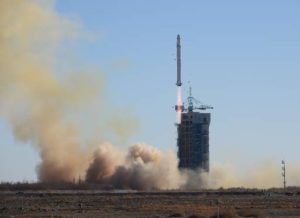
Chinese New Space Internet of Things (IoT) satellite communications company Commsat had seven small satellites launched as a rideshare on board a Long March-2D launch vehicle together with two Earth observation satellites for Saudi Arabia from the Jiuquan Satellite Launch Center in Northwest China on 7 December 2018.
The seven satellites are dubbed ‘Ladybeetles’ by Commsat, and include Ladybeetle-1, weighing 100 kilograms, three 6U CubeSats and three 3U CubeSats. They are manufactured by Commsat, a Beijing-based private satellite company funded by the Xi’an Institute of Optics and Precision Mechanics under the Chinese Academy of Sciences (CAS).
“We named them ‘ladybeetles’ as we hope they are down-to-earth, bring qualified services for our clients and have strong vitality,” said Xie Tao, founder and CEO of Commsat, speaking to Xinhua.
Xie told Xinhua that Ladybeetle-1 will become a commercial success due to its advantages in cost and flexibility. “A satellite at a weight of about 100 kg can accommodate more payloads than smaller minisatellites, but will consume much less power when connecting with ground terminals than big satellites weighing over a tonne,” he said.
The Ladybeetle satellites will be used to test a closed-loop system for IoT connectivity capability that includes satellites, cloud computing platforms, ground control stations, and terminals, according to Peng Yuanyuan, co-founder and chief operating officer at Commsat.
“We expect that IoT will mushroom in 2020, with about 20 billion terminals being connected to it. However, only 10 percent of our globe is covered by the ground network, and many things, such as ships, pipelines and wildlife, are scattered across vast areas without the network,” Peng told Xinhua.
Commsat plans to launch an additional four satellites in 2019 and to complete the deployment of a constellation of 72 satellites by 2022, Peng said.
Peng also said that Commsat’s satellites will provide data to a digital sports wristwatch to monitor the heart rates and temperatures of client athletes while they participate in sporting activities. Other IoT applications developed by Commsat include a necklace for giant pandas released back into the wild so that their movements, health, and activities can be monitored by the Ladybeetle satellites.
The Ladybeetle satellites will also be used track and monitor shipping containers as they traverse the globe by sea, rail, and by truck.
Commsat launched China’s first shared education satellite Young Pioneer 1 in February 2018. Young Pioneer 1 (named after the youth organisation of the Chinese Communist Party) shares its data resources with primary and secondary schools, as well as other education institutions, equipped with ground stations in China and provides students with wireless communication and space photography experiences.
Commsat’s commercial success will likely rest on its ability to serve the Chinese IoT market since foreign companies that provide similar services, such as Australia’s Fleet Space Technologies, are barred by Chinese law from providing satellite-based communications services within China.
“Commercial aerospace is a burgeoning industry, and we will do our best to realize our dreams,” Xie told Xinhua.





